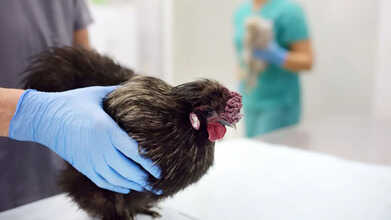- Health Conditions A-Z
- Health & Wellness
- Nutrition
- Fitness
- Health News
- Ayurveda
- Videos
- Medicine A-Z
- Parenting
Meet Louise Brown- The World’s First IVF Baby

Meet Louise Brown- The World’s First IVF Baby And The Innovators Who Changed The Face Of Infertility Treatment Forever
Almost half a century ago, a maverick event marked the course of medical history into a new and revolutionary phase. The birth of Louise Brown on 25th July 1978 marked the world's first baby born through a process of In-Vitro Fertilization or IVF. With Louise Brown, hope for millions of infertile couples dawned across the globe and massive debates followed regarding the ethics of assisted reproduction.
The new drama for Netflix is titled Joy after Louise's middle name, takes viewers back to the great journey of pioneers for this groundbreaking achievement. Louise, 46 now and working at a bakery in Bristol, has heard more than her share of thanks from strangers. She's quick to say, however, that it is her parents and the triumvirate of British visionaries-physician Robert Edwards, embryology nurse Jean Purdy, and gynecologic surgeon Patrick Steptoe-who faced incredible obstacles to make her existence possible.
“I still get people come up to me saying, ‘Oh, you’re amazing.’ And I’m like, ‘I didn’t do anything, it was Mum and Dad and the three doctors.’ It’s lovely people who want to thank them,” told The US Sun.
Netflix drama Joy looks at the sacrifices made by the team to create IVF. Dr. Robert Edwards started his research into fertilization in 1955, but in 1968, he was the first to fertilize a human egg. However, the success did not attract encouraging support from the medical fraternity, and Edwards did not get any funds for continued research. He, along with nurse Jean Purdy and surgeon Patrick Steptoe, planned a clinic in an abandoned ward of Royal Oldham Hospital.
The couple had personal and professional challenges. Edwards was away from his family and children for 170 miles, Purdy had conflict with her religious mother, and Steptoe was putting off his retirement dreams. Public opposition further tested their strength, and opponents referred to their work as unnatural and even vandalized their clinic with the word "Frankenbabies."
Their diligence paid off after years of trial and error. A breakthrough came when Edwards decided to use a naturally produced egg instead of stimulating the ovaries through hormones. This new approach proved successful with Louise's mother, Lesley, who had been trying to conceive for a decade.
A Miracle Amidst Controversy
Lesley Brown and her husband, John, decided they would like a child even though the odds were completely stacked against them. Diagnosed with blocked fallopian tubes, Lesley was told that her chances of conceiving were one in a million. Lesley approached Steptoe for assistance after a gynecological operation she was obliged to pay for herself, thanks to a win on her football pools. The Browns were entered in the experimental IVF procedure.
Lesley’s faith in the team was unwavering. Louise recounted, “If they had said, ‘Go into Trafalgar Square and stand on your head naked and you’ll get pregnant,’ she would have”, as reported in The US Sun.
The process worked on the 101st attempt. A single egg fertilized in a petri dish with John's sperm was successfully implanted in Lesley's womb. Nine months later, Louise was delivered via Caesarean section, with the world's media waiting outside the hospital.
Although successful, the aftermath of birth for Louise was far from smooth. Her family received death threats and vile messages - once even a smashed test tube through the post with a foetus-like object inside - and Louise herself was subjected to over 100 tests as a newborn to dispel doubts about her health.
While her birth was a scientific success, it was also an intensely personal one. "When I had my sons, I realized how good those people were,"* Louise said, speaking of the sacrifices of her parents and the scientists."
The film Joy honors the work of the trio, especially Jean Purdy, who died at 39 years of age in 1985. Although she played a critical role, the historical accounts of her work were often overlooked. Her name wasn't put on the plaque celebrating the team's triumph until 2022.
It was Dr Robert Edwards, who continued to keep in touch with Louise even up to his death in 2013, who was rewarded with the Nobel Prize in 2010 for his work on IVF. Jean and Patrick were both deceased by then.
Louise summarizes, "They have done it for 12 million of us. I owe them my life. I'd do anything for any of them, my parents, and the three scientists.
Today, over 12 million babies worldwide have been born through IVF-a testament to the vision and perseverance of Edwards, Purdy, and Steptoe. Louise Brown's story, now immortalized in Joy, is as much a story of medical innovation as it is about human resilience and the power of hope.
The Long-Term Effects of IVF on Modern Health Care
Birth of Louise Brown was more than a medical milestone; it led to revolution in reproductive healthcare. Successive decades have changed millions of lives through IVF technology with hope for individuals and couples wanting a child. Beyond the origins, the field of ART has evolved into a wide research sector that pushes beyond the frontiers of science and redefines possible interventions in human reproduction.
Success in IVF has led to research on related techniques, such as intracytoplasmic sperm injection (ICSI), vitrified eggs, and preimplantation genetic testing. These all granted the power of reproductive control, allowing even in defiance of age, genetic conditions, or cancer treatments, to plan a family.
The principles developed by the original IVF team have paved the way for better understanding of reproductive biology, innovation in treating problems like polycystic ovary syndrome (PCOS), and endometriosis. The existence of IVF has raised awareness about infertility and helped reduce the stigma around seeking medical help.
Still, with every medical discovery, IVF has its unique share of hurdles. Many issues concerned with accessibility and affordability ensue and take center stage in the ART discourse, and along with the potential to transform lives, IVF is still expensive for many people, a challenge for global health organizations to equitably access.
Health care providers emphasize the value of education and support provided to patients at every step of the IVF process. IVF often requires multiple attempts and is often physically, emotionally, and financially stressful. Support for psychological well-being has increasingly been an essential element of treatment through counseling and stress management in IVF clinics.
What Does A Black Box Warning On Your Prescription Drug Really Mean?

Credits: Canva
Not every medicine carries the same level of risk. Some drugs can trigger reactions that are severe or even life-threatening. When that possibility exists, the manufacturer is required to place a special notice inside the prescribing information. This highlighted section is known as a black box warning.
A black box warning is meant to draw clear attention to the most serious dangers linked to a drug. Many medicines fall under this category. Still, having the warning in place does not automatically make the treatment unsafe. When a drug is used correctly and monitored by a trained professional, the benefits may outweigh the risks.
The sections below outline what an FDA black box warning means, why a medicine might receive one, and how it may influence your treatment plan.
What Is An FDA Black Box Warning And What Does It Signify?
A black box warning is the strongest caution that the FDA can attach to a prescription drug. You might also see it described as a boxed warning.
The presence of this warning does not mean a person should never take the medication. Instead, it alerts doctors and patients to serious potential harm. This information helps clinicians decide who is an appropriate candidate and under what circumstances the drug should be used.
Many medicines with boxed warnings remain the best or only option for certain conditions.
How Serious Is A Black Box Warning?
A drug receives this type of label when it has been linked to outcomes such as permanent injury, hospitalisation, or death. These warnings should be read carefully, and patients should discuss them openly with their healthcare provider.
Doctors follow specific precautions when prescribing drugs that carry this label to minimize unnecessary risk.
Where Can I Find A Drug’s Black Box Warning?
The warning sits at the very top of the medication’s official package insert. Its placement is deliberate so it stands out immediately. The text is printed inside a bold black border, which is how the term “black box” took hold.
You may not always receive the full package insert from the pharmacy. However, you might receive a medication guide if the drug is considered high-risk. These guides describe proper use and highlight major side effects. You can also look up medication guides online.
Information about boxed warnings is available from multiple sources. The FDA website, the drug manufacturer’s website, and medical reference sites used by clinicians all include these details.
How Does A Drug End Up With A Black Box Warning?
Every prescription drug must go through extensive testing before it reaches the market. During this process, researchers aim to uncover risks that could require a boxed warning from the start. Even so, some side effects only appear once large numbers of people begin using the drug in everyday settings.
Because of this, most black box warnings are added after a medicine has already been approved. The FDA continues to monitor safety reports through MedWatch, a program where patients, physicians, and companies can report problems.
These reports are gathered in a database called the FDA Adverse Event Reporting System. When the agency notices a pattern of serious reactions, they investigate. If needed, they update the prescribing information and add a boxed warning so that future users are clearly informed.
Think Your Hormones Are Out Of Balance? Doctors Reveal The Warning Signs You Shouldn’t Ignore

Credits: Canva
People assigned female at birth live with hormone shifts throughout their lives. These chemical messengers guide nearly every system in the body. The swings linked to periods, pregnancy or menopause are easy to recognise, but many other factors can unsettle hormone levels.
The body produces more than fifty hormones through the endocrine system, and changes in any of them can signal a deeper health concern. Low insulin may point toward diabetes. Excess cortisol can influence weight gain. Other hormones, like melatonin, rise and fall through the day as part of normal rhythm. And the gradual drop in estrogen and progesterone as women approach menopause is also expected.
What Causes Hormonal Imbalance?
Puberty, pregnancy and menopause naturally reshape hormone activity. Beyond these, several conditions can disrupt normal patterns. Problems with the adrenal gland, thyroid disorders, eating disorders, congenital adrenal hyperplasia, Cushing’s syndrome, diabetes or PCOS can all change your hormone levels. Changes may also stem from stress, certain medicines, tumours, cysts or environmental chemicals.
Interest in hormones has grown recently. Earlier this month, the Food and Drug Administration agreed to remove the boxed warning on menopause hormone therapy after reviewing the evidence. The decision prompted fresh discussion among women considering treatment. Clinicians say many patients are reaching out with new questions, especially in an era filled with quick tests and supplements marketed as hormone balancers. It can be difficult to tell when testing is truly needed.
Warning Signs Of Hormonal Imbalance
As each hormone plays a different role, symptoms vary widely. These are some of the more frequent changes seen in people, as per UCLA Health.
1. Menstrual changes: Shifts in estrogen and related hormones can alter the monthly cycle. Periods may become heavier, lighter, irregular or go missing. Stress, diet and exercise can contribute as well, but hormonal swings remain a leading cause.
2. Hair changes: Hair often reacts quickly to hormonal shifts. Pregnancy can bring thicker strands, while imbalances may trigger hair thinning or hair growth in unexpected places. Excessive facial hair may suggest elevated androgens. Hair loss can point toward a thyroid concern.
3. Skin Changes: Hormonal shifts can influence skin colour, texture and oil production. Acne may flare during pregnancy due to rising progesterone. Darkened patches of skin may appear on areas like the neck, groin or beneath the breasts when estrogen or progesterone levels change.
4. Sexual and vaginal symptoms: Lower estrogen levels, especially with age, can reduce libido and cause vaginal dryness or pain during intercourse. Some women may experience vaginal atrophy when estrogen remains low for long periods.
5. Weight changes: Sudden weight gain or weight loss can reflect a hormonal issue. Many women notice weight gain after menopause. Thyroid disorders, PCOS and Cushing’s syndrome are also linked to changes in body weight.
6. Mood and sleep difficulties: Falling estrogen levels influence serotonin, a chemical important for stable mood. Low serotonin can contribute to anxiety, irritability or low mood. These disruptions often spill into sleep. Some women also report night sweats or trouble staying asleep.
7. Digestive issues: Estrogen and progesterone affect digestion. When these hormones shift, the gut may respond with bloating, constipation or diarrhoea. Some research has linked hormonal changes in people AFAB to irritable bowel syndrome. Many notice digestive changes around their menstrual cycle.
What To Do If You Suspect A Hormonal Imbalance
There is no single test that measures every hormone, and at-home kits only cover a few markers. The safest first step is to speak with your primary care doctor. They can look at your overall health and decide what evaluations are appropriate.
Diagnosis may include:
- A physical exam and review of your medical history
- Checking prescriptions or supplements that may influence hormones
- Blood, urine or saliva tests to measure specific hormone levels
- A pelvic exam to check for cysts or growths
- An ultrasound to look at the ovaries, uterus, thyroid or pituitary gland
Bird Flu In US: How Is The New H5N5 Strain Different From H5N1?

Credits: Canva
As bird flu continues to trouble several countries, health officials in the United States have reported the first known human case of the H5N5 subtype of avian influenza. The Washington State Department of Health announced on November 14, 2025, that the virus was found in a resident of Grays Harbor County.
The patient, an older adult with existing medical issues, is currently in the hospital. Authorities noted that the individual kept poultry at home that had contact with wild birds, which is believed to be the likely source of the infection, though the investigation is still underway. Since H5N5 is newly identified in humans, many are asking whether it differs from the earlier H5N1 strain.
What Is the H5N1 Strain?
H5N1 is a highly pathogenic form of avian influenza that mainly affects birds but can also infect mammals, including humans. It can lead to severe illness in people and has a high fatality rate, though it rarely spreads from one person to another, as per the World Health Organization. The virus has moved across continents in wild and farmed birds and has recently been found in dairy cattle and several other mammals.
What Is The New H5N5 Strain?
The “new” H5N1 strain refers to the 2.3.4.4b clade of highly pathogenic avian influenza (HPAI), which has caused a widespread animal outbreak since appearing in 2020. This version is a newer genetic branch of H5N1 and has swept through wild birds, poultry farms and an increasing range of mammals, including dairy herds in the United States. At present, the patient infected in the U.S. has been diagnosed with the newer H5N5 subtype.
How Is H5N5 Different From H5N1?
According to the CDC, both H5N5 and H5N1 fall under the avian influenza family, with the main distinction being the type of neuraminidase (N) protein on the virus surface. H5N5 contains the N5 protein, while H5N1 carries the N1 protein. Although this genetic change can influence viral features, their overall pattern of illness and symptoms is expected to be much the same, particularly in birds and livestock.
The genetic structure is the only difference, with H5N1 strain containing a subtype of influenza A with a segmented genome while the other has a new reassortant virus formed from several subtypes, possibly including H5N1, as per National Institute of Health.
Is A Vaccine Available For The H5N1 Bird Flu Strain?
Vaccines for bird flu do exist, but they are not intended for general public use and are not easily available for everyday protection. Some vaccines have been created and stored for possible deployment in people at higher risk, such as poultry workers and farm staff, and they are also used in animals like chickens to help manage outbreaks. The United States and several other countries have stockpiled H5N1-specific vaccines that could be rolled out if the threat to humans grows. A few nations, including Finland, are already offering them to certain high-risk groups. At the moment, there is no advice for the wider public to take a bird flu vaccine, as there is no sustained human-to-human spread and no mass-market human vaccine in use.
© 2024 Bennett, Coleman & Company Limited

